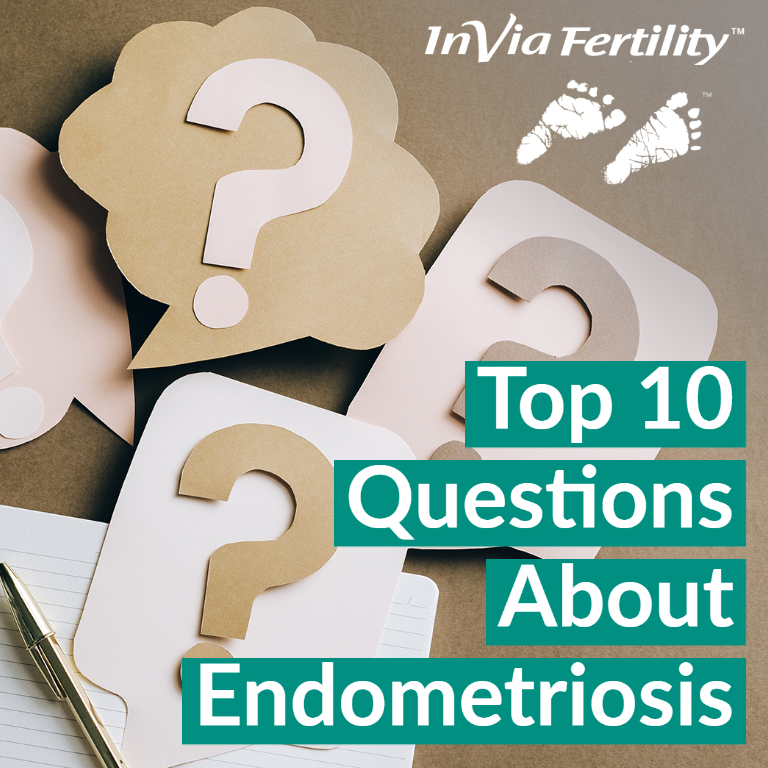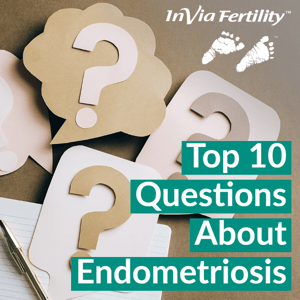We are experiencing a very high volume of calls and messages and ask for your patience. We will answer your portal messages within 48 hours.
We are experiencing a very high volume of calls and messages and ask for your patience. We will answer your portal messages within 48 hours.

 Endometriosis affects one in ten women in the United States, and can cause fertility problems.
Endometriosis affects one in ten women in the United States, and can cause fertility problems.
At InVia Fertility, we have treated many women who have this condition over the years. Here are the top ten most common questions we've received about it:
Endometriosis is a condition when the lining of the uterus (endometrium) is found outside the uterus. These misplaced tissues are referred to as “endometrial implants”. Endometriosis occurs most commonly in women between the ages of 25 and 44. It can also occur in teenagers, although this is less common. Women who have given birth after the age of 30 may also be more prone to develop it.
The commonest site is in the abdomen on the ovaries, fallopian tubes, on the pelvic sidewalls, the area between the vagina and rectum (cul de sac) and the outer surface of the uterus. Other sites for these endometrial growths may include the bladder, bowel, vagina, cervix, vulva, and in abdominal surgical scars. Less commonly they are found in the lung, arm, thigh, and other locations.
These misplaced tissues develop into growths or lesions which respond to the menstrual cycle in the same way that the tissue of the uterine lining does: each month the tissue builds up, breaks down, and sheds. Normally, menstrual blood flows from the uterus and out of the body through the vagina. However, the blood and tissue shed from endometrial implants has no way of leaving the body. This results in internal bleeding, breakdown of the blood and tissue from the lesions, and inflammation -- and can cause pain, infertility, scar tissue formation, adhesions, and bowel problems.
Other symptoms include:
In addition, many women with endometriosis may suffer from: allergies, chemical sensitivities, frequent yeast infections.
Laparoscopy is the commonest technique used to diagnose endometriosis. This is a procedure where a fiber-optic telescope is inserted through the belly button (umbilicus) to look at the pelvic structures. A video camera is attached to the laparoscope and the surgeon will observe the pelvic findings on a television screen. Pictures can be taken and sometimes a biopsy can be done to confirm the diagnosis of endometriosis. A laparoscopy usually shows the location, size, and extent of the growths. This helps the doctor and patient make better treatment choices.
Ultrasound can suggest the presence of endometriosis when there is a typical ovarian cyst (endometrioma) present, but most imaging methods cannot show other types of endometrial growths.
The cause of endometriosis is unknown. There are several theories that have been proposed.
The commonest staging system used was the one proposed by the American Society for Reproductive Medicine in 1996. This is based on the laparoscopic appearance of the pelvis. The visual appearance of the extent of the implants, and the presence of scar tissue are evaluated.
The disease can be minimal, mild, moderate or severe (Stage I – IV). The presence of an endometrioma or obliteration of the cul de sac is automatically considered as severe (Stage IV) endometriosis.
Apparent risk factors for endometriosis also include a low body mass index (BMI), alcohol use, and smoking. African-American women are less likely than Caucasian women to have endometriosis.
There are certain steps that a woman can take to either help prevent endometriosis or keep it from becoming worse:
Other blog posts cover common questions about endometriosis, endometriosis treatment and IVF, pros and cons of endometriosis surgery, and the different types of endometriosis surgery.
To see a Board Certified fertility specialist with expertise in endometriosis and IVF and other fertility treatments, schedule an appointment at one of InVia’s four Chicagoland locations.
[hs_action id="4078"]

Entire Website © 2003 - 2020
Karande and Associates d/b/a InVia
Fertility Specialists
